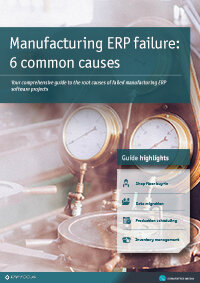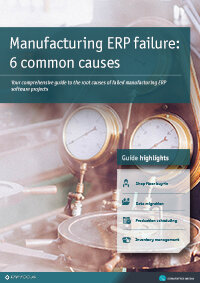How to thoroughly test your manufacturing ERP
Testing is only one phase of ERP implementation in a manufacturing environment, but many consider it the most crucial phase.
Whether you choose an off-the-shelf package that claims best-of-breed features or decide to customize or develop your own manufacturing ERP, there is one important, common factor – both need to work in your business and deliver the improvements you used to justify the new ERP. If you skip or under-resource testing, you increase the risk of costly production and compliance failures.
What should be tested in manufacturing? Everything
Write a purchase order and receive it. Receive one line to inventory and another to expense or capital assets. Does the PO receipt pass through incoming quality inspection as it should? Do you see the inventory quantity increase? Do the debits and credits on the finance side align the way you expect? Start with simple tests like these. You will likely find that the results are good, but there will be cases where the system doesn’t work as expected.
Dig as deep as is necessary and understand what went wrong.
Was it a training deficiency related to the person testing?
Was there a data migration issue?
Maybe there was a configuration setting you had overlooked. Fix the problem and test again until you know the result will be what you intend.
Recommended reading: Manufacturing ERP failure - 6 common causes
You will always fix problems that completely stop your ERP processing transactions, but any small problems left unfixed will still be considered a failure, even if only to a small group of users.
One example may be the procurement of a wire component that is bought by weight of a reel but is used by length. What formula converts pounds to centimeters? Testing your manufacturing ERP would have shown you had to buy in length or change the process to issue by weight. This situation would make inventory valuation much more difficult than it should be.
Thorough testing is the only way to be certain your manufacturing ERP provides the results you need.
Make compliance and traceability explicit test cases. Be sure you can retrieve quality data to satisfy any compliance requirements. Your customer wants to know that the people working on their products have documented training. Test that the ERP can store training data related to production workers. Test that the system prevents users without required training from starting production jobs tied to customer or regulatory rules; failure here could lead to the loss of an important customer or certification.
Types of ERP tests to include
Include a mix of manual and automated tests across these categories:
- Functional tests (core manufacturing flows: procurement → receiving → inspection → inventory → production → shipping).
- Integration tests (MES, PLM, quality systems, finance, and third-party logistics).
- User acceptance testing (UAT) with actual end users executing real scenarios.
- Regression testing to catch failures after configuration changes or upgrades.
- Performance and load testing to verify the ERP handles expected transaction volumes during peak production.
- Security and access control tests to ensure role separation and data protection.
Prioritize test cases that protect production continuity and regulatory obligations first; automate repetitive regression and smoke tests to reduce risk for subsequent releases.
Follow the process flow
Start small and mirror real work: create a PO, receive into inventory, route through incoming quality inspection, post inventory movements, run a job that consumes components, complete a finished good transaction, and post the financial entries.
Log expected vs actual results and link each failed case to root cause: data, configuration, permissions, integration, or user training. Repeat and close each finding. This approach reduces “we hoped it would work” deployments.
ERP testing services and specialist support
If internal capacity is limited, consider contracting ERP testing services that provide domain expertise (manufacturing workflows), test automation, and integration testing. Good vendors can supply test plans, test scripts, automation frameworks, and experienced testers familiar with ERP-to-MES/PLM integrations.
A staging environment (build it right)
The final consideration when it comes to testing your ERP is the construction of your system testing environment. There are a couple of different options here, but the ideal scenario for most is the creation of a staging system.
This staging system should be a replica of the database you constructed during data migration, in which your test process can be applied without the risk of process disruption.
If constructed correctly, this staging system can then push successful changes to a live or pre-go-live iteration of the system. In a manufacturing environment, this means users from all departments can test processes along the production chain with the knowledge that rigorous testing is not a risk to system health. Aim for parity between staging and production for software, integrations, and representative data sets, while masking any sensitive production data.
Note: getting 100% parity is often impractical; document the differences and build compensating tests that cover the gap (for example, scale testing in a controlled performance environment if exact hardware parity is not possible).
Final thoughts and key takeaways
Thorough testing is the only way to be certain your manufacturing ERP provides the results you need. Record test cases, owners, pass/fail criteria, and remediation plans in a shared test management tool.
Assign clear owners for fixes (business, IT, vendor) and agree on exit criteria for each testing phase. Use short, frequent test cycles for UAT and regression to keep the project moving while catching defects early.
Free white paper

Manufacturing ERP Failure: 6 Common Causes
Get your comprehensive guide to the causes of manufacturing ERP failure

Related articles
-

ERP migration steps (your ERP migration checklist)
How to construct the smoothest ERP migration plan possible
-

CMMC Compliance: What Aerospace and Defense Manufacturers Need to Know
Key insights on CMMC compliance, deadlines, and securing DoD contracts with CMMC 2.0 certificatio...
-

The importance of proper ERP testing
Why thorough testing should be a key part of your ERP implementation plan

